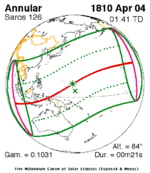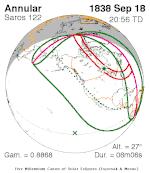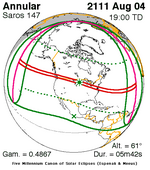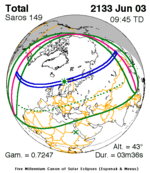Solar eclipse of May 17, 1882
A total solar eclipse occurred on Wednesday, May 17, 1882. A solar eclipse occurs when the Moon passes between Earth and the Sun, thereby totally or partly obscuring the image of the Sun for a viewer on Earth. A total solar eclipse occurs when the Moon's apparent diameter is larger than the Sun's, blocking all direct sunlight, turning day into darkness. Totality occurs in a narrow path across Earth's surface, with the partial solar eclipse visible over a surrounding region thousands of kilometres wide. In locations as of present or today, totality was visible in Burkina Faso, Ghana, Niger, Nigeria, Chad, Libya, Egypt (African part), Suez Canal, Egypt (Asian part), Gulf of Aqaba, Saudi Arabia, Iraq, Iran, Turkmenistan, Uzbekistan, Tajikistan, Kyrgyzstan, China and East China Sea. Totality began in Burkina Faso and ended in East China Sea. Occurring 4.2 days after perigee (Perigee on May 13, 1882), the Moon’s apparent diameter was 0.9% larger than average.
Observations
A party of observers gathered in Egypt to watch the eclipse were greatly surprised when they observed a bright streak near to the Sun once totality began. By a remarkable coincidence, the eclipse had coincided with the perihelion passage of a Kreutz comet. The comet would otherwise have gone unnoticed—its sighting during the eclipse was the only observation of it. Photographs of the eclipse revealed that the comet had moved noticeably during the 1m50s eclipse, as would be expected for a comet racing past the Sun at almost 500 km/s. The comet is sometimes referred to as Tewfik, after Tewfik Pasha, the Khedive of Egypt at the time.[1]

Related eclipses
Saros 126
This eclipse is a part of Saros series 126, repeating every 18 years, 11 days, and containing 72 events. The series started with a partial solar eclipse on March 10, 1179. It contains annular eclipses from June 4, 1323 through April 4, 1810; hybrid eclipses from April 14, 1828 through May 6, 1864; and total eclipses from May 17, 1882 through August 23, 2044. The series ends at member 72 as a partial eclipse on May 3, 2459. Its eclipses are tabulated in three columns; every third eclipse in the same column is one exeligmos apart, so they all cast shadows over approximately the same parts of the Earth.
The longest duration of annularity was produced by member 11 at 6 minutes, 30 seconds on June 26, 1359, and the longest duration of totality was produced by member 45 at 2 minutes, 36 seconds on July 10, 1972. All eclipses in this series occur at the Moon’s descending node of orbit.[2]
| Series members 36–57 occur between 1801 and 2200: | ||
|---|---|---|
| 36 | 37 | 38 |
 April 4, 1810 |  April 14, 1828 |  April 25, 1846 |
| 39 | 40 | 41 |
 May 6, 1864 |  May 17, 1882 |  May 28, 1900 |
| 42 | 43 | 44 |
 June 8, 1918 |  June 19, 1936 |  June 30, 1954 |
| 45 | 46 | 47 |
 July 10, 1972 |  July 22, 1990 |  August 1, 2008 |
| 48 | 49 | 50 |
 August 12, 2026 |  August 23, 2044 |  September 3, 2062 |
| 51 | 52 | 53 |
 September 13, 2080 |  September 25, 2098 |  October 6, 2116 |
| 54 | 55 | 56 |
 October 17, 2134 |  October 28, 2152 |  November 8, 2170 |
| 57 | ||
 November 18, 2188 | ||
Tritos series
This eclipse is a part of a tritos cycle, repeating at alternating nodes every 135 synodic months (≈ 3986.63 days, or 11 years minus 1 month). Their appearance and longitude are irregular due to a lack of synchronization with the anomalistic month (period of perigee), but groupings of 3 tritos cycles (≈ 33 years minus 3 months) come close (≈ 434.044 anomalistic months), so eclipses are similar in these groupings.
| Series members between 1801 and 2200 | ||||
|---|---|---|---|---|
 December 21, 1805 (Saros 119) |  November 19, 1816 (Saros 120) |  October 20, 1827 (Saros 121) |  September 18, 1838 (Saros 122) |  August 18, 1849 (Saros 123) |
 July 18, 1860 (Saros 124) |  June 18, 1871 (Saros 125) |  May 17, 1882 (Saros 126) |  April 16, 1893 (Saros 127) |  March 17, 1904 (Saros 128) |
 February 14, 1915 (Saros 129) |  January 14, 1926 (Saros 130) |  December 13, 1936 (Saros 131) |  November 12, 1947 (Saros 132) |  October 12, 1958 (Saros 133) |
 September 11, 1969 (Saros 134) |  August 10, 1980 (Saros 135) |  July 11, 1991 (Saros 136) |  June 10, 2002 (Saros 137) |  May 10, 2013 (Saros 138) |
 April 8, 2024 (Saros 139) |  March 9, 2035 (Saros 140) |  February 5, 2046 (Saros 141) |  January 5, 2057 (Saros 142) |  December 6, 2067 (Saros 143) |
 November 4, 2078 (Saros 144) |  October 4, 2089 (Saros 145) |  September 4, 2100 (Saros 146) |  August 4, 2111 (Saros 147) |  July 4, 2122 (Saros 148) |
 June 3, 2133 (Saros 149) |  May 3, 2144 (Saros 150) |  April 2, 2155 (Saros 151) |  March 2, 2166 (Saros 152) |  January 29, 2177 (Saros 153) |
 December 29, 2187 (Saros 154) |  November 28, 2198 (Saros 155) | |||
Notes
References
- NASA graphic
- Googlemap
- NASA Besselian elements
- Sketchs of Solar Corona May 17, 1882
- v
- t
- e
| By era | |
|---|---|
| Saros series (list) | |
| Visibility | |
| Historical |
|

Total/hybrid eclipses
→ next total/hybrid
- 1133
- 1185
- 1560
- 1598
- 1652
- 1654
- 1673
- 1706
- 1715
- 1724
- 1766
- 1778
- 1780
- 1806
- 1816
- 1824
- 1842
- 1851
- 1853
- 1857
- 1858
- 1860
- 1865
- 1867
- 1868
- 1869
- 1870
- 1871
- 1874
- 1875
- 1878
- 1882
- 1883
- 1885
- 1886
- 1887
- Jan. 1889
- Dec. 1889
- 1893
- 1896
- 1898
- 1900
- 1901
- 1903
- 1904
- 1905
- 1907
- Jan. 1908
- Dec. 1908
- 1909
- 1910
- 1911
- Apr. 1912
- Oct. 1912
- 1914
- 1916
- 1918
- 1919
- 1921
- 1922
- 1923
- 1925
- 1926
- 1927
- 1928
- 1929
- Apr. 1930
- Oct. 1930
- 1932
- 1934
- 1936
- 1937
- 1938
- 1939
- 1940
- 1941
- 1943
- Jan. 1944
- 1945
- 1947
- 1948
- 1950
- 1952
- 1954
- 1955
- 1956
- 1957
- 1958
- 1959
- 1961
- 1962
- 1963
- 1965
- 1966
- 1967
- 1968
- 1970
- 1972
- 1973
- 1974
- 1976
- 1977
- 1979
- 1980
- 1981
- 1983
- 1984
- 1985
- 1986
- 1987
- 1988
- 1990
- 1991
- 1992
- 1994
- 1995
- 1997
- 1998
- 1999
- 2001
- 2002
- 2003
- 2005
- 2006
- 2008
- 2009
- 2010
- 2012
- 2013
- 2015
- 2016
- 2017
- 2019
- 2020
- 2021
- 2023
- 2024
- → 2026
- 2027
- 2028
- 2030
- 2031
- 2033
- 2034
- 2035
- 2037
- 2038
- 2039
- 2041
- 2042
- 2043
- 2044
- 2045
- 2046
- 2048
- 2049
- 2050
- 2052
- 2053
- 2055
- Jan. 2057
- Dec. 2057
- 2059
- 2060
- 2061
- 2063
- 2064
- 2066
- 2067
- 2068
- 2070
- 2071
- 2072
- 2073
- 2075
- 2076
- 2077
- 2078
- 2079
- 2081
- 2082
- 2084
- 2086
- 2088
- 2089
- 2090
- 2091
- 2093
- 2094
- 2095
- 2096
- 2097
- 2099
- 2100
- 2186

Annular eclipses
→ next annular
- 1820
- 1854
- 1879
- 1889
- 1900
- 1901
- 1903
- 1904
- 1905
- 1907
- 1908
- 1911
- 1914
- Feb. 1915
- Aug. 1915
- 1916
- 1917
- 1918
- 1919
- 1921
- 1922
- 1923
- 1925
- 1926
- 1927
- 1929
- 1932
- Feb. 1933
- Aug. 1933
- 1934
- 1935
- 1936
- 1937
- 1939
- 1940
- 1941
- 1943
- Jul. 1944
- 1945
- 1947
- 1948
- 1950
- Mar. 1951
- Sep. 1951
- 1952
- Jan. 1954
- Dec. 1954
- 1955
- 1957
- 1958
- 1959
- 1961
- 1962
- 1963
- 1965
- 1966
- Mar. 1969
- Sep. 1969
- 1970
- 1972
- Jan. 1973
- Dec. 1973
- 1976
- 1977
- 1979
- 1980
- 1981
- 1983
- 1984
- 1987
- 1988
- 1990
- 1991
- 1992
- 1994
- 1995
- 1998
- 1999
- 2001
- 2002
- 2003
- 2005
- 2006
- 2008
- 2009
- 2010
- 2012
- 2013
- 2014
- 2016
- 2017
- 2019
- 2020
- 2021
- 2023
- → 2024
- 2026
- 2027
- 2028
- 2030
- 2031
- 2032
- 2034
- 2035
- 2036
- Jan. 2038
- Jul. 2038
- 2039
- 2041
- 2042
- 2043
- 2044
- 2045
- 2046
- 2048
- 2049
- 2052
- 2053
- Jan. 2056
- Jul. 2056
- 2057
- 2059
- 2060
- 2061
- 2063
- 2064
- 2066
- 2067
- 2070
- 2071
- Jan. 2074
- Jul. 2074
- 2075
- 2077
- 2078
- 2079
- 2081
- 2082
- 2084
- Jun. 2085
- Dec. 2085
- 2088
- 2089
- Feb. 2092
- Aug. 2092
- 2093
- 2095
- 2096
- 2097
- 2099
- 2100

Partial eclipses
→ next partial
- Jan. 1639
- Apr. 1902
- May 1902
- Oct. 1902
- Feb. 1906
- Jul. 1906
- Aug. 1906
- Dec. 1909
- Nov. 1910
- Apr. 1913
- Aug. 1913
- Sep. 1913
- Dec. 1916
- Jan. 1917
- Jun. 1917
- Jul. 1917
- May 1920
- Nov. 1920
- Mar. 1924
- Jul. 1924
- Aug. 1924
- Dec. 1927
- Jun. 1928
- Nov. 1928
- Apr. 1931
- Sep. 1931
- Oct. 1931
- Jan. 1935
- Feb. 1935
- Jun. 1935
- Jul. 1935
- Nov. 1938
- Mar. 1942
- Aug. 1942
- Sep. 1942
- Jan. 1946
- May 1946
- Jun. 1946
- Nov. 1946
- Apr. 1949
- Oct. 1949
- Feb. 1953
- Jul. 1953
- Aug. 1953
- Dec. 1956
- Mar. 1960
- Sep. 1960
- Jan. 1964
- Jun. 1964
- Jul. 1964
- Dec. 1964
- May 1967
- Mar. 1968
- Feb. 1971
- Jul. 1971
- Aug. 1971
- Dec. 1974
- May 1975
- Nov. 1975
- Apr. 1978
- Oct. 1978
- Jan. 1982
- Jun. 1982
- Jul. 1982
- Dec. 1982
- May 1985
- Apr. 1986
- Mar. 1989
- Aug. 1989
- Dec. 1992
- May 1993
- Nov. 1993
- Apr. 1996
- Oct. 1996
- Sep. 1997
- Feb. 2000
- 1 Jul. 2000
- 31 Jul. 2000
- Dec. 2000
- Apr. 2004
- Oct. 2004
- Mar. 2007
- Sep. 2007
- Jan. 2011
- Jun. 2011
- Jul. 2011
- Nov. 2011
- Oct. 2014
- Sep. 2015
- Feb. 2018
- Jul. 2018
- Aug. 2018
- Jan. 2019
- Apr. 2022
- Oct. 2022
- → Mar. 2025
- Sep. 2025
- Jan. 2029
- Jun. 2029
- Jul. 2029
- Dec. 2029
- 2032
- 2033
- Feb. 2036
- Jul. 2036
- Aug. 2036
- 2037
- May 2040
- Nov. 2040
- Jan. 2047
- Jun. 2047
- Jul. 2047
- Dec. 2047
- 2050
- Apr. 2051
- Oct. 2051
- Mar. 2054
- Aug. 2054
- Sep. 2054
- 2055
- May 2058
- Jun. 2058
- Nov. 2058
- Mar. 2062
- Sep. 2062
- Feb. 2065
- Jul. 2065
- Aug. 2065
- Dec. 2065
- 2068
- Apr. 2069
- May 2069
- Oct. 2069
- 2072
- 2073
- Jun. 2076
- Jul. 2076
- Nov. 2076
- Feb. 2083
- Jul. 2083
- Aug. 2083
- 2084
- 2086
- May 2087
- Jun. 2087
- Oct. 2087
- 2090
- 2091
- Jun. 2094
- Jul. 2094
- Dec. 2094
- Apr. 2098
- Sep. 2098
- Oct. 2098
 Astronomy portal
Astronomy portal Solar System portal
Solar System portal Category
Category













